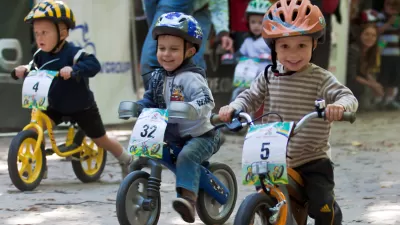Today, October 8, is National Walk and Bike to School Day, and yet street conditions across the United States continue to prevent kids from getting to school safely without being chauffeured. Lynn Richards of CNU says we can do better.

Lynn Richards, president of The Congress for the New Urbanism (CNU), biked to school with her son recently and was shocked to see how dangerous conditions were for pedestrians and bikers trying to get to this neighborhood school. "At the school's intersection, bike lanes fade into nothingness, leaving young bike riders to determine their own routes," writes Richards. "The school driveway doesn't even have a stop or yield sign, so cars enter the street without pausing, putting bikers and walkers at risk."
Richards cites some damning statistics, including the fact that motor vehicle crashes are the leading cause of death for children ages four through 14. The answer? Better street design. "Street design and schools' transportation management priorities send strong signals to parents and students that cars trump all other modes of getting around," she writes.
Richards's most potentially controversial recommendation is to require permits for drivers dropping their kids off at school. "Or perhaps blocks surrounding the school could designate pedestrian-only zones at the beginning and end of the school day," she concludes.
FULL STORY: Make it Safe for Our Kids to Walk or Bike to School

Maui's Vacation Rental Debate Turns Ugly
Verbal attacks, misinformation campaigns and fistfights plague a high-stakes debate to convert thousands of vacation rentals into long-term housing.

Planetizen Federal Action Tracker
A weekly monitor of how Trump’s orders and actions are impacting planners and planning in America.

San Francisco Suspends Traffic Calming Amidst Record Deaths
Citing “a challenging fiscal landscape,” the city will cease the program on the heels of 42 traffic deaths, including 24 pedestrians.

Bend, Oregon Zoning Reforms Prioritize Small-Scale Housing
The city altered its zoning code to allow multi-family housing and eliminated parking mandates citywide.

Amtrak Cutting Jobs, Funding to High-Speed Rail
The agency plans to cut 10 percent of its workforce and has confirmed it will not fund new high-speed rail projects.

LA Denies Basic Services to Unhoused Residents
The city has repeatedly failed to respond to requests for trash pickup at encampment sites, and eliminated a program that provided mobile showers and toilets.
Urban Design for Planners 1: Software Tools
This six-course series explores essential urban design concepts using open source software and equips planners with the tools they need to participate fully in the urban design process.
Planning for Universal Design
Learn the tools for implementing Universal Design in planning regulations.
planning NEXT
Appalachian Highlands Housing Partners
Mpact (founded as Rail~Volution)
City of Camden Redevelopment Agency
City of Astoria
City of Portland
City of Laramie




























